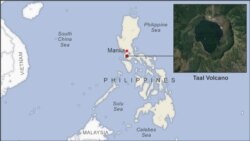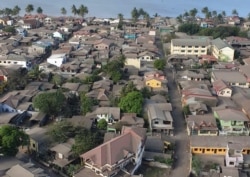When Mount Taal started spewing plumes of ash in the Philippines a few days ago, thousands were ordered to evacuate and the president himself handed over aid money. It did not take Rodrigo Duterte long to get there or see the gravity of the situation. Taal stands next to a growing industrial belt and is just 109 kilometers outside the capital, Manila.
Quick responses such as these are seen as signs that officials are trying harder than ever to minimize the impact of more eruptions from the especially active volcano. Their grasp of the danger results from a learning curve that has spanned multiple natural disasters, including other volcanic activity.
“What we’ve seen so far in terms of ash fall and consequent disruptions to tourism and air transport, as well as just sort of damage to agriculture, is relatively minor so far, but I think the potential is there. If there is a major volcanic explosion, that then impacts logistics services because of the manufacturing belt that’s around metro Manila,” said Christian de Guzman, vice president and senior credit officer with Moody’s Sovereign Risk Group.
The volcano, just 311 meters high, is the most active in the Philippines. The cone sits inside a lake in one of the archipelago’s wealthier provinces, one heavily frequented by local tourists and moneyed retirees as well as farmers selling coffee and ornamental plants. A bigger explosion could spark flows of mud, ash and hot debris, the magazine Scientific American said in a report Tuesday.
The government’s Department of Science and Technology warned Thursday that a “hazardous explosive eruption is possible within hours to days.”
Philippine officials understand the risk, analysts say. The central government has ordered thousands of people to evacuate since January 12 and Duterte personally handed over $212 million worth of aid, his website says. Catholic Church groups, which form a powerful nongovernmental force in the Philippines, have opened centers for evacuees and offered extra help for 3,000 people who need food or water, the Vatican News website says.
The Department of Science and Technology publishes daily online updates on Taal’s activity.
Officials understand the urgency more now than before, said Jonathan Ravelas, chief market strategist with Banco de Oro UniBank in metro Manila. They may have learned from Mount Pinatubo, he said. A 1991 eruption from the mountain just 91 kilometers from Manila killed 847 people and severely damaged infrastructure. It also prompted the withdrawal of U.S. forces from a nearby airbase.
“I think the help that came after evacuating people is a bit more coordinated,” Ravelas said of the past week. “I guess government agencies were there to provide certain things.”
Companies with factories around Manila have been warned about possible power and water outages if volcanic activity ramps up, Ravelas said.
Over the past decade, manufacturers of goods such as electronics and automotive parts, have set up factories in three provinces near Manila, including Batangas, to draw on the work force’s low wages and English-language skills. The region contributed more then $28 billion to the $313.6 billion national gross domestic product in 2017.
Manufacturers are expected to expand on 148 hectares among the three provinces through 2021, mostly in Batangas, domestic news website Inquirer.net says. Most factories are built “to code” and have backup power systems, de Guzman said.
Roads and other infrastructure have improved to support manufacturing, but companies have little means to “mitigate” any damage there, de Guzman said.
Although disaster forecasting usually focuses on more likely events such as typhoons and earthquakes, the ash spewed this week is shifting attention to the hazards posed by a volcano so close to Manila, said Maria Ela Atienza, political science professor at the University of the Philippines Diliman.
Manila itself is too far to be covered by volcanic flows, but winds from the south could send ash its way. After Taal sent ash as high as 15 kilometers into the air this week, flights in the capital were canceled.
“This is also a wake-up call in the case of the Philippines that given its location we should really be prepared for different types of disasters, particularly volcanic eruptions, and it can happen anywhere — and this time it’s affecting areas that are actually developed,” Atienza said.
Eventually officials may need to “rethink tourism,” she said.
Before this month, Taal had erupted 33 times since 1572 and most recently in 1977, the Scientific American report says.











